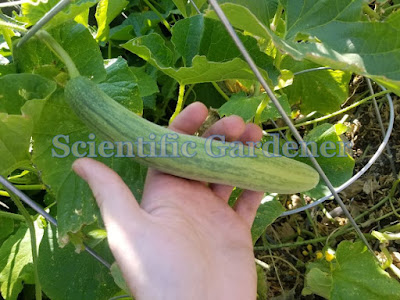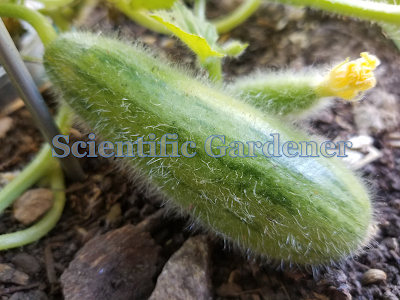Seeds of the Ayra cucumber came into my possession through a USDA germplasm accession from Rajasthan, India. The plants grew very similar to other Cucumis melo that I have grown before and continued to grow very well in my raised bed gardens until the time when they began to fruit. That is when I began to notice very big difference between the Ayra and any other cucumber I have ever grown before.
Extraordinarily short fine dense hairs cover the outside of the fruit, producing a reflective sheen over the entire outer surface of the cucumber. This trait is difficult to identify unless one gets up close to the cucumber. If reflected from the sun to one’s eyes, the nearly ability of the fruit surface to reflect the sunlight can be nearly blinding.
Dry texture. The fruit is not as juicy as some other Cucumis melo fruit I have grown before. In fact, the texture is nearly as dry as a zucchini. It is still completely edible and nourishing, but thirst quenching it is not.
Color changing. While many other fruit become lighter with maturity, this fruit can often become darker. Green or semi-green fruit can turn a burnt reddish-brown color. The reason for this is unknown, but it may have something to do with the color of the sap that comes from the fruit.
Gelatin-textured pulp inside the mature fruit. As the fruit matures, the outer portion continues to dry out, giving much of its moisture to the inner portion of the fruit. Similar to a Maldives cucumber-melon the inside of the mature fruit has gelatin-like pulp surrounding the seeds.
As easy as the plants were to grow the seed proved a little challenging to process. The pulp held tight to the seeds, requiring fermentation and unless the seeds were kept cool, germination rates would quickly deteriorate. As a result, I ended up discarding well over half of my newly harvested seed due to poor germination.
While there is one company in India that I am aware of that sells Ayra cucumbers, my experience is that they are very difficult to acquire from the company.
If you would like to learn a little more about the Ayra cucumber, here is a research paper on this fruit and its differences from the standard Cucumis melo cucumber.
https://www.researchgate.net/publication/326303115_A_less-known_vegetable_melon_landrace_Arya_Cucumis_melo_L_from_Rajasthan_and_Haryana_India_morphological_biochemical_and_taxonomic_study







































































































